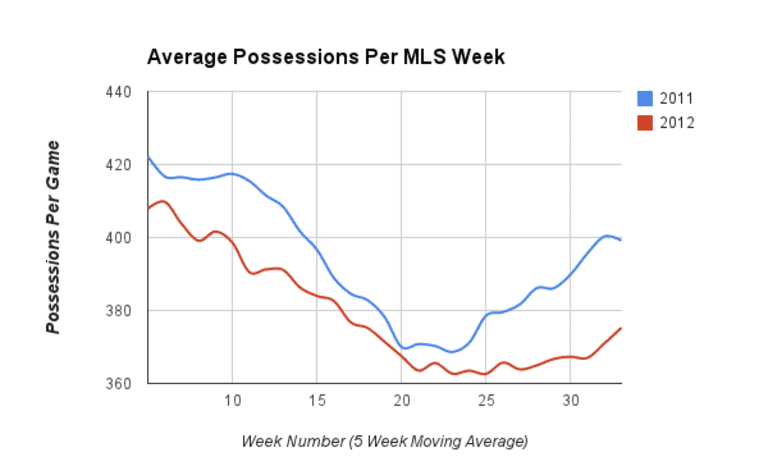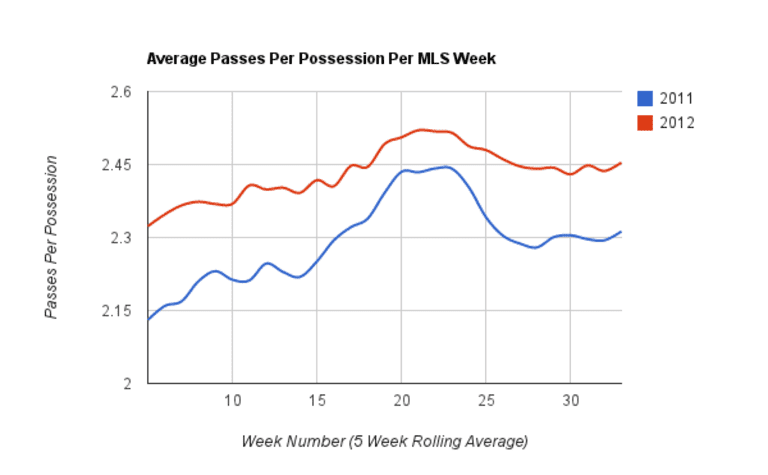At the beginning of the 2013 MLS season, it's important to recognize that individual matches are not the only things to ebb and flow. MLS itself sees league-wide trends that fluctuate over the course of the season. The rate of possession – or speed of play – is one of them. And with a careful look into the MLS chalkboards powered by Opta, we can glean significant insight.
Below is the average number of possessions in each MLS match over the course of the 2011 and 2012 seasons. The trend is clear: The beginning of the season commonly features matches with a much higher rate of possession (more than 400 possessions per match). By week 20, this number drops significantly to around 370 possessions per match. After the trough of Week 20-25, the rate of possessions begin to rise and continues to rise until the end of the season.

While this is only two seasons of data, the trend is intuitive. At the beginning of the season, where un-gelled locker-rooms and inconsistent lineups are common, possessions are expected to be wasted at a higher rate. In the middle of the season, with most teams firing on all cylinders, possessions are generally more efficient. And during the season's home stretch, with many teams jockeying for playoff positions, it's not surprising to see the rate of play increase as teams become just a bit more desperate for those extra points that can be the difference between a postseason spot and a cold, lonely November.
Central Winger: More to possession stats than meets eye
This is scatterplot of the average number of passes in a possession versus the number of possessions in a game for the 2011 and 2012 MLS seasons. This trend is also clear – as the number of possessions shrink, the average number of passes in each possession grows.

Since possessions with more passes take more time off the clock, games that feature longer passing chains generally leave less time for additional possessions in the game.
At this point, it's probably worthwhile to explain just how possession is being defined in this experiment. Each time a player plays a deliberate action on the ball, they are considered in possession. And, until the opposing team manages to play their own deliberate action on the ball, the original team retains possession. Therefore, by extension, each team will have the same amount of possessions in a single match. This is not perfect, but it is certainly a worthy proxy to use for rate of possession.
Central Winger: Sifting through Opta data to sequence the soccer genome
Here is the season-long fluctuation of average passes per possession for the 2011 and 2012 MLS seasons. With the clear relationship shown between possession rate and the average length of passing sequences, it shouldn't be much of a surprise that this inversely mimics the average number of possessions per game.

If we can assume that MLS's quality of play is roughly defined as a function of quality of possession and rate of possession, these two time series tell an interesting story when combined. At the beginning of the season, the quality of MLS play increases mostly on the back of increasing lengths of possession. In the tail end of the season, MLS quality continues to grow by increasing the rate of play while keeping the number of passes per possession relatively stable.
This is perhaps even more exciting when we consider that the first two weeks of 2013 have the highest season-opening passes per possession since this type of data started being collected. The eyeball test says that the league is becoming more technical, and the numbers here back it up.
For more reading on possession-based MLS research (and a more specific definition of possession), check out Alex Olshansky's Tempo-Free Soccer Blog where he examines possession based efficiency through the scope of Major League Soccer.














